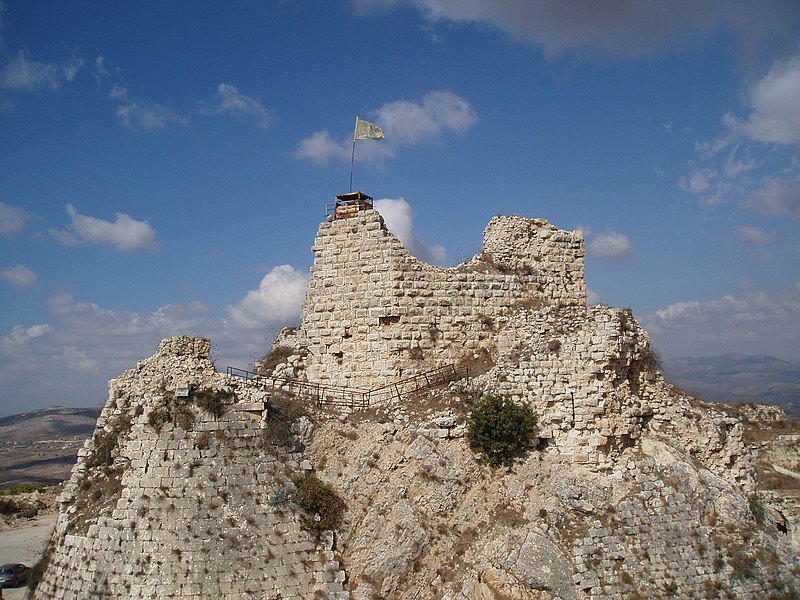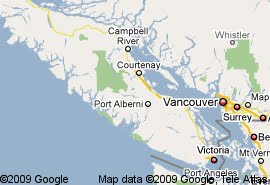
The ruins of Beaufort Castle in 2005
Beaufort or Belfort (Shaqif Arnun or Qala'at al-Shaqif in Arabic)[1] is a Crusader fortress in Nabatieh Governorate, Southern Lebanon, about 1 kilometre (0.62 mi) to the south-south-east of the village of Arnoun. There was a fortification on the site before it was captured by Fulk, King of Jerusalem, in 1139 and construction of the Crusader castle probably began soon after. Saladin captured Beaufort in 1190, but 60 years later Crusaders re-took it. In 1268 Sultan Baibars captured the castle.
The castle was named "bel fort" or "beau fort" (French for "beautiful fortress") by the Crusaders who occupied the castle in the 12th century. Its Arabic name Qala'at al-Shaqif means Castle of the High Rock (shqif is the Aramaic word for "high rock"). Beaufort provides one of the few cases where a medieval castle proved of military value and utility also in modern warfare, as its late 20th-century history shows.
Link:
http://en.wikipedia.org/wiki/File:Chateau_de_Beaufort.jpg
 Beaufort Castle,
Arnoun:
Beaufort Castle,
Arnoun:
The cliff-top Crusader Castle,
which has changed hands countless times over the
centuries, is seen as a symbol of shifting power in
southern Lebanon. The Beaufort Castle was
completed in 1139 A.D. by the Crusaders. It stands on
a sheer escarpment almost a 1000m above the valley
below overlooking the Litani river. T. E.
Lawrence once described it as the finest medieval
castle in the Arab world.
On the 24th of May 2000,
retreating Israeli Occupation Forces destroyed most
parts of the Castle, despite appeals by the Lebanese
Prime Minister to the United Nations and the
International Community to spare the Crusader
castle.
http://tyros.leb.net/beaufort/

Link: http://news.bbc.co.uk/2/hi/middle_east/762297.stm
http://tyros.leb.net/beaufort/
Beaufort Castle suffers in Israeli retreat

The imposing silhouette dominates south Lebanon
Retreating
Israeli troops appear to have destroyed parts of Beaufort Castle in
Southern Lebanon, despite appeals by the Lebanese prime minister for the
Crusader fort to be spared.
Local residents reported that a huge explosion engulfed the castle at about midnight local time on Tuesday night.
The blast lit up the sky and rocked the area around the castle, just
after Israeli troops withdrew from the castle under artillery and air
cover.
The castle had been a garrison headquarters and the nerve centre of Israel's 22-year occupation of southern Lebanon.
Lebanese Prime Minister Salim al-Hoss wrote to UN Secretary-General
Kofi Annan and other world leaders on Sunday, imploring them to prevent
Israel destroying one of Lebanon's most famous historic sites.
Abandoned castle
When Hezbollah fighters and local residents moved into the abandoned castle at dawn they found smouldering wreckage and clothing discarded by the retreating forces.
Concrete bunkers at the castle had been blown up, bringing down part of the historic stone wall.
"I brought my kids here to teach them a lesson about how we defeated
Israel," said Salem Sweidan, escorting his two young children through
the smoking debris.
Symbol of shifting power
The cliff-top Crusader castle, which has changed hands countless times over the centuries, is seen as a symbol of shifting power in southern Lebanon.
Beaufort Castle was completed in 1139 by the Crusaders. It stands on a
sheer escarpment almost a 1000m above the valley below, overlooking the
Litani river.
T E Lawrence once described it as the finest medieval castle in the Arab world.
Every invading army since the Crusades has seized, held and lost Beaufort, from Saladin in the 12th century right down to Palestinian guerrillas, who occupied the castle in the 1970s.
For the past eighteen years, Beaufort has been held by the Israeli army, which drove out the PLO in a fierce battle during which much of the castle was destroyed.

The symbol of foreign occupation in Hezbollah's hands
|
The castle had been a garrison headquarters and the nerve centre of Israel's 22-year occupation of southern Lebanon.
I brought my kids here to teach then a lesson about how we defeated Israel
|
Lebanese villager visiting Beaufort Castle
|
When Hezbollah fighters and local residents moved into the abandoned castle at dawn they found smouldering wreckage and clothing discarded by the retreating forces.

Retreating Israel soldiers blow up an outpost near the Beaufort Castle
|
Symbol of shifting power
The cliff-top Crusader castle, which has changed hands countless times over the centuries, is seen as a symbol of shifting power in southern Lebanon.

Lebanese villagers reclaim the castle
|
Every invading army since the Crusades has seized, held and lost Beaufort, from Saladin in the 12th century right down to Palestinian guerrillas, who occupied the castle in the 1970s.
For the past eighteen years, Beaufort has been held by the Israeli army, which drove out the PLO in a fierce battle during which much of the castle was destroyed.
Link: http://news.bbc.co.uk/2/hi/middle_east/762297.stm
Great Movie:
| Beaufort |
|---|
 |
|---|
| Directed by | Joseph Cedar |
|---|---|
| Produced by | Moshe Edery |
| Written by | Ron Leshem Joseph Cedar |
| Starring | Oshri Cohen Itay Tiran Eli Eltonyo Ohad Knoller Itay Turgeman |
| Music by | Ishai Adar |
| Cinematography | Ofe |
Beaufort (Hebrew: בופור) is a 2007 Israeli war film. The film was directed by Joseph Cedar and was co-written by Cedar and Ron Leshem, based on Leshem's novel of the same name. The film is about an IDF unit stationed at the Beaufort post in Southern Lebanon during the South Lebanon conflict, and their commander, Liraz Librati, who was the last commander of the Beaufort castle before the Israeli withdrawal in 2000.
The film takes place in the year 2000, the year of the IDF withdrawal from the Israeli Security Zone in southern Lebanon. It chronicles the daily routine of a group of soldiers positioned at the 12th century Crusader stronghold of Beaufort Castle, their feelings and their fears, and explores their moral dilemmas in the days preceding the withdrawal and end of the 18-year South Lebanon conflict.
The film's director, himself an IDF veteran who was stationed in Lebanon during the first Lebanon war,[1] uses the stone walls of Beaufort castle as a symbol of the futility and endlessness of war. The film was shot during the spring of 2006 at Nimrod Fortress, a similar mountaintop fort in the Golan Heights. Cedar said he was influenced by the film Das Boot, and the World War I "bunker films", when creating the underground tunnels and mazes of the Beaufort.[2] He also said that Paths of Glory was a heavy influence, specifically on the bomb-disarming mission scene.[1] Useful historical information for understanding the movie can be found in the article on the original capture of Beaufort in 1982 by the Israeli army.
Filming was completed in June, just a month before the second war in Lebanon broke out.

No comments:
Post a Comment